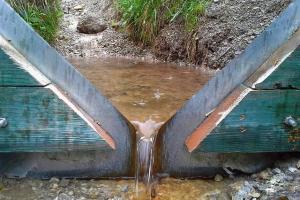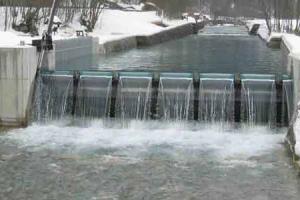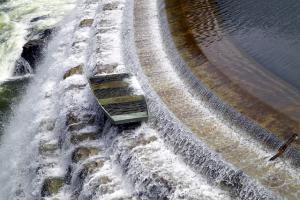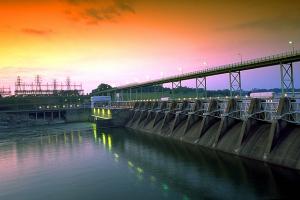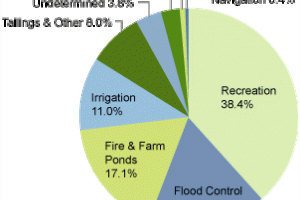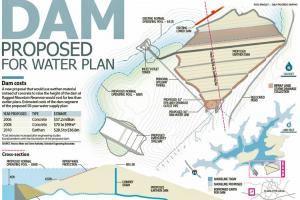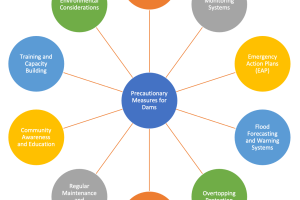Classification and Types of Dams based on different Criteria
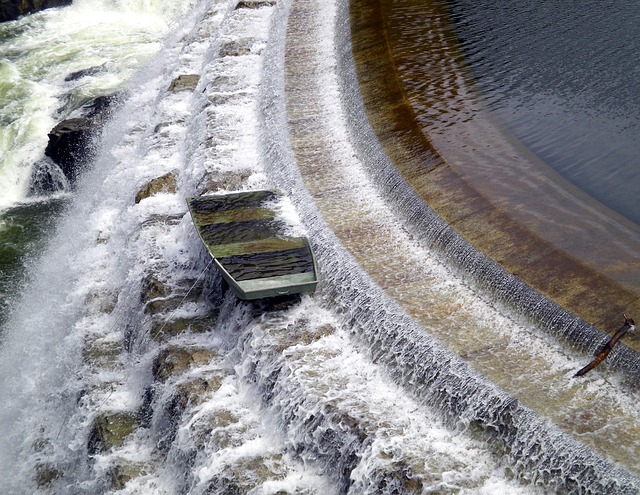
Types of Dams
Below are the types of dams based on different criteria. Types of dams on the basis of materials used in dam construction:
- Rigid Dams (Concrete dams, steel dams, timber dams etc)
- Non-Rigid dams (rockfill dams)
Classification of dam types with respect to size/height of the dam
- Low dam / Small dam (How to build small dams)
- Medium dams
- High dam / Large dams
Classification of dam according to its purpose/use
- Water supply dam/Irrigation dams
- Power dams
- Multipurpose dams
- Flood control dams
Classification of Dams According To Location
On-Channel:
Dam is constructed across the main water feeding river. Examples Tarbela, Mangla, Simly, Hub dam. To increase the water availability water from other rivers may be diverted to the dam through feeder channels e.g. Kurram Tangi dam.
Off-Channel:
Dam is constructed on a channel having much smaller flow. Major storage water is transferred from a different nearby river. This is done due to non-availability of suitable/economic dam site on the major flow river. Example Akhori dam, Replacement dams for Mangla and Tarbela.
Classification of Dams According to Release Pattern
Storage dam:
Water is stored and later released through an outlet for consumptive or non-consumptive purposes as per requirements.
Recharging dam:
There is no outlet provided to release water and all incoming water is retained. The water infiltrates through the foundation and/or dam body. The main purpose of the dam is to induce recharge to ground water system in the area. Small release in d/s channel to allow seepage in the channel bed.
Delay action dam / retarding dam:
These dams are used to retard the peak flow of flash floods. There may or may not be any control over the outflow. For no control over the outflow the outflow rate varies as function of storage volume / water depth in the dam. The flood peak is thus considerably attenuated. The outlet capacity is set that maximum outflow discharge do not exceed the safe capacity of the downstream river during highest flood. The reservoir empties fully after the flood. For control on outflow by gates (detention dam) , the flow is released in such a pattern to retain the water for long time but there is enough storage available to store next flood event. These dams are usually meant to reduce flood damages as well as to induce maximum recharge in the area. One type of such dam is a porous dam built of a porous embankment, e.g. stone gabions.
Tailings dam:
These dams are constructed away from any river along a topographic slope by constructing small dikes on three or all four sides to store slurry / waste of mineral mining and processing facilities. The water evaporates or is evacuated and the solid contents dry up filling up the storage capacity.
Diversion dam:
These are hydraulic structures with a main purpose to raise water level to divert flow into the off taking channels / canals/ hydropower pressure tunnels and penstock. These are preferably called as barrage or canal head works. The storage created by these is minimal. E.g. Patrind Weir.
Coffer dam:
These are small temporary dams built across the river on upstream and downstream side of the main dam in order to keep the flow away and the working area dry. The u/s coffer dam causes the flow through the diversion system and d/s coffer dam prevents the flooding of the working from backwater effects. After completion of the main dam the u/s coffer is usually abandoned and drowns in the reservoir while d/s coffer dam is dismantled and removed.
Classification of dams according to Hydraulic Design
Non-Overflow dam:
Flow is not allowed over the embankment crest for reasons of dam safety. (earth, rock) dams.
Overflow dam
The dam body is made of strong material as concrete and flow is allowed over the dam crest (Concrete dams)
Classification of dams according to Size
Dams may be classified as small, medium or large as under:
Small
USBR defined small dam as one having maximum height < 15 m (50 ft).
Medium:
Intermediate sizes 40-70 ft
Large:
ICOLD defined large dam as a dam that follows one or more of following conditions. (Thomas 1976 P-0)
Dam height > 15 m (50 ft) measured from lowest portion of the general foundation area to the crest
A dam height 10-15 m but it compiles with at least one of the following condition:
- crest of dam longer than 500 m
- capacity of the resulting reservoir more than 1 million m3
- maximum flood discharge more than 2000 m3/s (70,000 cfs)
- dam has specially difficult foundation problems
- dam is of unusual design
Unique: Dams exceeding 100 m are considered as unique. Every aspect of its design and construction must be treated as a problem specifically related to that particular site.
Classification of Dams According to Filling and Emptying Mode
The storage of a dam may be filled and emptied in short time (one season) or long time (several seasons). The dams are defined as:
Seasonal:
Seasonal dams are filled and then emptied within the same water year (September to August). Example Tarbela dam. Thus water level in the dam varies from maximum (normal conservation level) to minimum (dead storage level) in most years. Such dams have annual releases usually equal or little more than the minimum annual flow. For very wet or very dry years the reservoir may not reach the extreme levels. The seasonal dams spread the water stored in wet months over to dry months in the same year.
Carry over:
Filling and emptying of a carry-over dam reservoir continues over more than one year (e.g. 4 to 5 years). Example. Hub Dam, Kurram Tangi Dam. Thus water stored in wet years may be released during subsequent dry years The annual releases are usually more than minimum annual flow but equal to long term average annual flow. Applicable where wide variations in annual flows. Carry over dams spread storage during wet years/months over to dry years and months.
Types of Dams according to type of material
A dam can be made of earth, rock, concrete or wood. Dams are classified according to the materials used as under:
A. Embankment Dams
1. Earthfill Dam:
These are constructed of selected soils (0.001 ≤ d ≤ 100 mm) compacted uniformly and intensively in relatively thin layers (20 to 60 ± cm) and at controlled optimum moisture content. Compacted natural soils form more than 50% of the fill Material. Dams may be designed as: Homogeneous, Zoned or with impermeable core. Zoned part is made of relatively finer material that reduces seepage flow, e.g. clay. The fill material is placed as rolled, hydraulic fill or semi-hydraulic fill.
2. Rockfill dam:
Over 50% of fill material be of class ‘rock’ usually a graded rockfill (0.1 ≤ d ≤ 1000 mm) is filled in bulk or compacted in thin layers by heavy plant. Some impervious membranes/materials are placed in the interior or on u/s face of the embankment to stop/reduce seepage through the dam embankment. Dams section may be homogeneous, zoned, with impermeable core, or with asphalt or cement concrete face. Zoned part is made of relatively finer material that reduces seepage flow, e.g. clay. Core is made of clay, concrete, asphalt concrete etc.
3. Earthfill-rockfill or Earth-rock dams
These dams are made of mix of large proportions of earthfill and rockfill materials.
B. Concrete Dams
Concrete dams are formed of cement-concrete placed in the dam body. Concrete dam section designed such that the loading produces compression stress only and no tension is induced any where. The reinforcement is minimum mainly as temperature control. Concrete is placed in two ways: Reinforced concrete dam (RC dam) or Roller compacted concrete (RCC) dams. The variations of concrete dam include:
- Concrete gravity dam,
- Concrete arch dam and arch-gravity dam
- Multiple arch dam
- Double curvature or dome/cupola dam
- Buttress dam (head as diamond, roundhead, massive, decked etc)
- Hollow gravity dam
- Brick or rock masonry gravity dam
Rubble/random/stone masonry to fill dam section. Concrete / mass concrete as bulk material in dam section with steeper side slope. RCC section to take loadings, thus decrease section.
- Gravity dam: Stability due to its mass. Dam straight or slightly curved u/s in plan (no arch action). The u/s face is vertical or nearly vertical, d/s sloping.
- Buttress dam: It consists of continuous u/s face supported at regular intervals by d/s buttress (massive buttress /diamond head, round head) with each section separate. Ambursen / flat slab buttress / decked buttress.
- Arch dam: Arch dam has considerable u/s plan curvature. U/s and d/s faces are nearly straight / vertical. Water loads are transferred onto the abutments or valley sides by arch action. Arch dam is structurally more efficient than concrete gravity dams (requires only 10-20% concrete). However abutment strength and geologic stability is critical to the structural integrity and safety of the dam. Multiple arch dams.
- Cupola/Dome/Double curvature dam: U/s & d/s faces curved in plan and profile section, curved in plan as well/ as arch (Part of a dome or shell structure).
- Hollow gravity section made hollow to reduce uplift pressure at d/s side and smaller total construction materials. (between gravity and buttress dams)
C. Timber/steel dam
The bulk of the dam is made of timber braces with timber board facings. Such dams were mostly constructed by early gold miners in California USA for obtaining river water for separating gold dust and getting water power; such dams are not practically used any longer. The face of earthfill or rockfill dams may be also fitted with timber board for seepage control.



